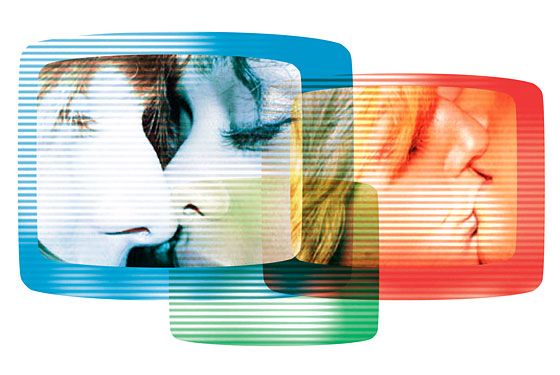
By the time this essay comes out, you’ll have been through the full hype cycle for MTV’s Skins twice, whether you like it or not. Even before the teen soap opera aired, it had been designated the moral outrage of the month, with the Parents Television Council accusing MTV of making kiddie porn, advertisers pulling out like a pack of teen boys, and the requisite point-counterpoint all over the op-eds; if only Tiger Mom had chimed in, MTV might have achieved the Full Elvis of prurient buzz.
Among the most damning of these write-ups was David Carr’s lacerating take in the New York Times, in which he contrasted the show’s consequence-free story with its reality-TV counterpart: Teen Mom, another MTV series, which is, perversely, the more honest and tough-minded of the two. Carr’s right about that—and he’s certainly correct that the pilot of Skins was remarkably unpleasant. Then again, the first episode of the original series—the British show the MTV series is based on—was also pretty bad, although it benefited from a less thuggish actor in the role of reptilian charmer Tony. I found the second episode of MTV’s remake slightly better, or at least more entertaining, since it focused on the equally obnoxious but more charismatic character of Tea, a half-Jewish, half-Italian lesbian—a reimagined version of the original series’s gay male character Maxxie. Spinning in short skirts and boy-panties, Tea seems designed to appeal to male fantasies, and not just those of teenagers. But she also plays a bit like a younger, more spoiled Shane from The L Word, which is hardly the worst idea in the world.
Because the truth is, if the show continues down the path of the British series, it could turn into something queasily addictive, not despite but because of its cheerful amorality. No sane person would compare Skins (either the British or the American version) to Freaks and Geeks, My So-Called Life, or Buffy the Vampire Slayer, the last decade’s trifecta of game-changing teen shows. It is neither subtle nor especially original. But that doesn’t mean it has no life in it. Skins is more like Glee crossed with the film Kids then laced with a bit of Gossip Girl—a fever dream about appetites fulfilled, set in a lurid universe where poreless packs throw zipless orgies, then weep over their own tragic back stories. (The American version even managed to weave in a Holocaust survivor.)
It’s a familiar breed of naughty catnip, one that appeared again and again in my own youth, each time packaged with its own moral scare: Less Than Zero comes to mind. Skins is a lighter, less ennui-ridden story than anything Bret Easton Ellis came up with, but it has the same charge, that primal meld of decadence and self-dramatization, drugs and clueless adults. And of course, there are those sex scenes, which are hardly as graphic as the publicity suggests, but do involve a lot of gasping and flashed underwear, like an eighties Calvin Klein ad with a (slightly) better sense of humor.
And really, if Skins is reflexively racy, it’s simply imitating its elders, which have long blurred the line between “quality television” and “deniable porn.” You’d have to go back more than a decade, to the Bada Bing girls of The Sopranos, to trace this change. Before that, HBO had two distinct sets of programming: the highbrow (movies, docs, The Larry Sanders Show) and the lowbrow (sex, packaged as documentary: Taxicab Confessions, Real Sex, and G-string Divas). Dream On merged the two, then Oz pulled that concept up to a more ambitious level. But it was The Sopranos and Sex and the City that really perfected the recipe.
Along with Deadwood and Six Feet Under, these groundbreaking series provided reliable jolts of smut, reducing the chance that anyone might switch channels. And yet the shows were also excellent enough that you could argue that the scenes weren’t gratuitous—at least not most of the time. When TBS trimmed Samantha’s trysts during reruns, the show lost some of its brassy third-wave feminist roots. The Bada Bing girls were a more complicated matter: Those nameless naked actresses seemed like eye candy for a long time, but then David Chase brilliantly turned the screw toward the end, punishing viewers with one of his series’s most brutal story arcs, about a psychopath who beat a stripper to death, effectively casting an unsettling shadow over our own voyeurism.
Since Tony’s and Carrie’s heydays, each new slate of shows has gotten only more graphic. And somewhere along the way, the line between “shows teens watch,” “shows about teens,” and “shows about teens that adults watch” has utterly dissolved. I’m talking about series like True Blood, a porn Buffy packed with full-frontal vampire torture and werewolf gang-bangs, as well as its own moody adolescent vamp, Jessica; and Entourage, a boys-world fantasy with naked starlets popping out of every cake. There’s a whole slate of half-hour series whose plots seem specifically designed to allow for regular injections of kink, from Californication to Secret Diary of a Call Girl to Hung, several of which feature teen characters. Two newer dramas take the same approach, including Shameless, a raucous family drama that features graphic sex both hot and contrived, involving teens and adults. And Boardwalk Empire plays something like The Sopranos with the ethical stopper pulled out: an endless spray of flapper boobs, lesbian nuzzles angled toward the lens, and Paz de la Huerta’s ultranude performance as Queen of the Giggling Hussies.
The unsettling truth is that Skins fits perfectly within this landscape, in which teens worship Samantha Jones and thirtysomethings analyze Gossip Girl. If the advertisers don’t pull the plug in the next few weeks, there’s no reason MTV’s Skins couldn’t wriggle out of the moral panic it triggered, ideally by learning how to tap into a more distinctly American flavor of teen mayhem. When it comes to guilty pleasures, liveliness beats morality every time.
Skins
MTV.
Mondays at 10 p.m.